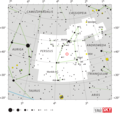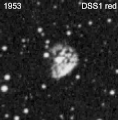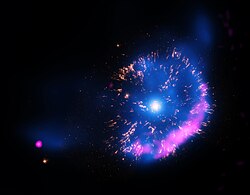astro.wikisort.org - Star
GK Persei (also Nova Persei 1901) was a bright nova first observed on Earth in 1901. It was discovered by Thomas David Anderson, an Edinburgh clergyman, at 02:40 UT on 22 February 1901 when it was at magnitude 2.7.[9][10] It reached a maximum magnitude of 0.2, the brightest nova of modern times until Nova Aquilae 1918. After fading into obscurity at about magnitude 12 to 13 during the early 20th century, GK Persei began displaying infrequent outbursts of 2 to 3 magnitudes (about 7 to 15 times quiescent brightness). Since about 1980, these outbursts have become quite regular, typically lasting about two months and occurring about every three years. Thus, GK Persei seems to have changed from a classical nova like Nova Aquilae 1918 to something resembling a typical dwarf nova-type cataclysmic variable star.
| Observation data Epoch J2000.0 Equinox J2000.0 | |
|---|---|
| Constellation | Perseus |
| Right ascension | 03h 31m 11.82s[1] |
| Declination | +43° 54′ 16.8″[1] |
| Apparent magnitude (V) | 0.02[2] - 14.0[3] |
| Characteristics | |
| Spectral type | K1IV[4] |
| Astrometry | |
| Radial velocity (Rv) | 5.5[5] km/s |
| Proper motion (μ) | RA: −6.878[6] mas/yr Dec.: −17.348[6] mas/yr |
| Parallax (π) | 2.3063 ± 0.0415 mas[6] |
| Distance | 1,440+29 −26 ly (442+9 −8[2] pc) |
| Absolute magnitude (MV) | −9.1 - +3.7[2] |
| Orbit[7] | |
| Period (P) | 1.996872 ± 0.000009 d |
| Inclination (i) | 67 ± 5° |
| Semi-amplitude (K2) (secondary) | 126.4 ± 0.9 km/s |
| Details[7] | |
| White dwarf | |
| Mass | 1.03+0.16 −0.11 M☉ |
| Subgiant | |
| Mass | 0.39+0.07 −0.06 M☉ |
| Radius | 2.26 ± 0.11 R☉ |
| Other designations | |
| Database references | |
| SIMBAD | data |
Surrounding GK Persei is the Firework nebula, a nova remnant first detected in 1902 consisting of an expanding cloud of gas and dust bubbles moving up to 1200 km/s.[11]

GK Persei has precise parallaxes reported from Gaia DR2 and Gaia EDR3,[12][6] but these are thought to be badly affected by the binary nature of the system. The Hubble Space Telescope has used a different method to derive the distance to GK Persei using nebular expansion velocity and compares that with its own astrometric parallax calculation. This gave a somewhat smaller parallax (larger distance) than the Gaia measurements.[13]
Properties
Novae consist of a main-sequence to giant star that accretes mass onto a white dwarf. The two stars of GK Persei orbit each other with a period of nearly 2 days. The white dwarf, with a mass of 1.03 M☉, has one of the highest masses measured in a cataclysmic variable. The donor star, having donated much of its mass to the white dwarf, is only 0.39 M☉ despite being a subgiant star.[7]
Gallery
 The location of GK Persei (circled in red)
The location of GK Persei (circled in red)- GK Persei by the 32-inch Schulman Telescope at the Mt. Lemmon Observatory.
 Expanding Nebula around GK Persei. Images range from 1953 to 2012.
Expanding Nebula around GK Persei. Images range from 1953 to 2012. Changing light-echo observed at the time of the 1901 Nova, hand-drawn by G.W. Ritchey at the Yerkes Observatory.
Changing light-echo observed at the time of the 1901 Nova, hand-drawn by G.W. Ritchey at the Yerkes Observatory.
References
- Downes, Ronald; Webbink, Ronald F.; Shara, Michael M. (April 1997), "A Catalog and Atlas of Cataclysmic Variables-Second Edition", Publications of the Astronomical Society of the Pacific, 109: 345–440, Bibcode:1997PASP..109..345D, doi:10.1086/133900
- Schaefer, Bradley E. (December 2018). "The distances to Novae as seen by Gaia". Monthly Notices of the Royal Astronomical Society. 481 (3): 3033–3051. arXiv:1809.00180. Bibcode:2018MNRAS.481.3033S. doi:10.1093/mnras/sty2388. S2CID 118925493.
- van Altena, William F.; Lee, J.T.; et al. (1995). The general catalogue of trigonometric [stellar] parallaxes. Bibcode:1995gcts.book.....V.
- Morales-Rueda, L.; Still, M.D.; Roche, P.; Wood, J.H.; Lockley, J.J. (January 2002). "The stellar mass ratio of GK Persei". Monthly Notices of the Royal Astronomical Society. 329 (3): 597–604. Bibcode:2002MNRAS.329..597M. doi:10.1046/j.1365-8711.2002.05013.x.
- Wilson, Ralph Elmer (January 1953). "General catalogue of stellar radial velocities". Carnegie Institute Washington D.C. Publication. Bibcode:1953GCRV..C......0W. Retrieved 25 January 2021.
- Brown, A. G. A.; et al. (Gaia collaboration) (2021). "Gaia Early Data Release 3: Summary of the contents and survey properties". Astronomy & Astrophysics. 649: A1. arXiv:2012.01533. Bibcode:2021A&A...649A...1G. doi:10.1051/0004-6361/202039657. S2CID 227254300. (Erratum: doi:10.1051/0004-6361/202039657e). Gaia EDR3 record for this source at VizieR.
- Álvarez-Hernández, A.; Torres, M A P.; Rodríguez-Gil, P.; Shahbaz, T.; Anupama, G. C.; Gazeas, K. D.; Pavana, M.; Raj, A.; Hakala, P.; Stone, G.; Gomez, S.; Jonker, P. G.; Ren, J-J; Cannizzaro, G.; Pastor-Marazuela, I.; Goff, W.; Corral-Santana, J. M.; Sabo, R. (2021). "The intermediate polar cataclysmic variable GK Persei 120 years after the nova explosion: A first dynamical mass study". Monthly Notices of the Royal Astronomical Society. 507 (4): 5805–5819. doi:10.1093/mnras/stab2547.
- "V* GK Per". SIMBAD. Centre de données astronomiques de Strasbourg. Retrieved 28 December 2016.
- Shears, Jeremy (2012). "The astronomizings of Dr. Anderson and the curious case of his disappearing nova" (PDF). The Journal of the British Astronomical Association. 123 (5): 270–279. arXiv:1209.4057. Bibcode:2013JBAA..123..270S. Retrieved 30 November 2020.
- Warner, B. (February 2006). "Where have all the novae gone?". Astronomy & Geophysics. 47 (1): 29–32. Bibcode:2006A&G....47a..29W. doi:10.1111/j.1468-4004.2006.47129.x. Retrieved 30 November 2020.
- "NOAO". Retrieved 22 June 2008.
- Brown, A. G. A.; et al. (Gaia collaboration) (August 2018). "Gaia Data Release 2: Summary of the contents and survey properties". Astronomy & Astrophysics. 616. A1. arXiv:1804.09365. Bibcode:2018A&A...616A...1G. doi:10.1051/0004-6361/201833051. Gaia DR2 record for this source at VizieR.
- Harrison, Thomas E.; et al. (2013). "Hubble Space Telescope Fine Guidance Sensor Parallaxes for Four Classical Novae". The Astrophysical Journal. 767 (1). 7. arXiv:1302.3245. Bibcode:2013ApJ...767....7H. doi:10.1088/0004-637X/767/1/7. S2CID 118376206.
External links
- http://www.daviddarling.info/encyclopedia/N/Nova_Persei_1901.html
- http://lheawww.gsfc.nasa.gov/users/mukai/iphome/systems/gkper.html
- GK Persei from the AAVSO
- APOD: GK Per: Nova of 1901, 2011 November 5
- GK Persei by Chandra
- Video showing the expansion of the nova remnant
На других языках
[de] GK Persei
GK Persei (auch Nova Persei 1901) war eine Nova, die 1901 im Sternbild Perseus aufleuchtete und mit einer maximalen Helligkeit von 0,2 mag eine der hellsten, neuzeitlich beobachteten Novae war. Als Novaüberrest, mit einer Ruhehelligkeit von 13,5 mag, ist GK Persei ein Kataklysmischer Veränderlicher (CV), der eine Reihe von Eigenschaften in sich vereint, die in dieser Kombination selten auftreten: Die Bahnperiode von GK Persei gehört mit 1,99 Tagen[4] zu den längsten in CVs beobachteten, und der Begleitstern ist ein Unterriese, und nicht wie in der Regel, ein Hauptreihenstern. Der akkretierende Weiße Zwerg ist magnetisch und rotiert mit einer Periode von 351 Sekunden[5], womit GK Persei den asynchronen, magnetischen CVs des Typs DQ-Herculis zuzuordnen ist.- [en] GK Persei
[es] GK Persei
GK Persei (GK Per)[2] es una estrella en la constelación de Perseo y una de las novas mejor conocidas. Se encuentra en la región entre Algol (β Persei) y Mirfak (α Persei). En condiciones normales su magnitud aparente es +13,1.[ru] GK Персея
GK Персея (GK Persei, GK Per, Nova Persei 1901) — яркая новая звезда, вспыхнувшая в 1901 году в созвездии Персея на расстоянии 1500 световых лет от Земли. Она достигла максимальной яркости 0m,2 звёздной величины, и была самой яркой новой звездой XX века, до тех пор пока в 1918 году в созвездии Орла не вспыхнула другая новая. В настоящее время её видимая звездная величина колеблется около значения 13m,5.[7].Другой контент может иметь иную лицензию. Перед использованием материалов сайта WikiSort.org внимательно изучите правила лицензирования конкретных элементов наполнения сайта.
WikiSort.org - проект по пересортировке и дополнению контента Википедии




